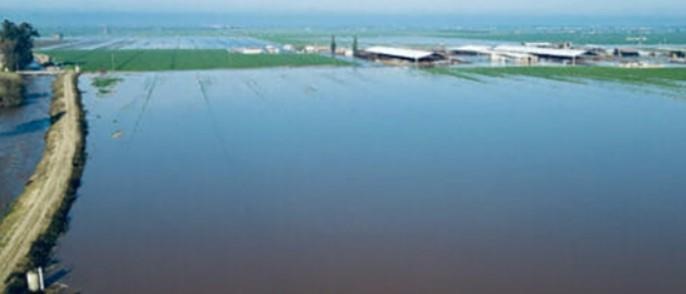For Joseph Goni, a fourth-generation dairy farmer in Tulare County, California, the region’s historic floods were part of family lore. As such, his grandfather, who lived through the 1955 deluge, often stressed the proper maintenance of the berms protecting the ranch from the nearby Tule River — a lesson echoed by his father, who faced a similar event in 1983.
But the epic flooding this past March was simply unprecedented, says the owner of Lerda-Goni Farms. After a winter of record snow in the Sierra Nevada Mountains, a sudden warm spell melted the lower reaches, unleashing nearly 40,000 acre-feet of water — a volume equal to more than a tenth of Las Vegas’s annual supply — in 48 hours. The torrent overwhelmed dams, swelled rivers, and crumbled levees, inundating entire farming communities, including Lerda-Goni and a dozen other ranches, and reawakening a long-dormant lake lying beneath the vast agricultural region.
With floodwater breaching six-foot high banks, “I don’t know what we could have done to prevent it,” says Goni. “It was just an insane amount of water in such a short amount of time.” Months later, he’s still shell-shocked from having to relocate his herd of 2,400 cows in the middle of the night — a Herculean effort pulled off by his team of 11 long-time employees, neighbors, and countless volunteers, some who hailed from as far away as Nevada.

All told, one official estimate pegs the dairy industry’s losses at $10 billion. While the lake has drained down to about 168 square miles, a chilly spring also kept the high-elevation snowpack at a slow melt, helping to avert an even greater calamity in the low-slung basin. Yet, as whole farming communities dig themselves out of the muddy ruins, the growing uncertainty of climate change is darkening a cloud over the future of the region’s largest industry — one valued at nearly $2 billion annually.
Following multiple years of drought, the diluvian whiplash is just the latest in a mounting list of burdens facing the basin’s largest industry, which pumps out 54 percent of California’s milk supply. As environmental adversity — along with the strain of rising costs and regulations — tightens the squeeze, many smaller, family-owned ranches have been caving to consolidation pressure. And that’s tipping the landscape in favor of mega-dairies — the large-scale operations that critics point to as disproportionate contributors of human-induced climate change.
At this point, “our farm is pretty self-sufficient,” says Goni, as he rushed to plant summer feed corn on his barely dry fields. His 580-acre farm grows enough forage to supply the herd, so “I’m good with where I’m at,” he adds. Still, the trend of getting big or getting out is all too real, adds the farmer, who’s seen plenty of small dairies pushed out in his lifetime. “But I’ll leave that [decision] for my nephews, for the next generation.”
Located in the southern reaches of the San Joaquin Valley, about 200 miles north of Los Angeles, Tulare Lake was once the largest body of freshwater west of the Mississippi River. Fed by four rivers flowing from the Sierra Nevadas, the shallow inland sea covered 1,000 square miles — more than four times the surface area of Lake Tahoe. Vast tule marshes surrounded its banks, creating a rich ecosystem teeming with fish and birds that, in turn, supported the Tachi Yokut and other Native American communities.
As westward expansion swept across the region in the late 1800s, settlers began draining the 40-foot-deep lake for farmland. Within decades, a network of dams, levees, and canals had dried up the basin, transforming the fertile crater into an agricultural hub. Today, the four counties sitting in the lake bed account for more than $25 billion in food and crop production, with Tulare County ranking number one in the nation for milk and oranges. Neighboring Fresno and Kern Counties top the list for almonds, while Kings County rules the state in cotton production.
But thirsty crops and cattle have taken their toll: Amid California’s cycles of drought, excessive groundwater pumping has left Central Valley basins the most overdrafted in the state. Although California’s Sustainable Groundwater Management Act (SGMA) aims to recharge them by regulating draws, the dried-up lake bed has long been collapsing under the massive weight of industrialized agriculture — to the tune of a couple of inches per month.
As climate change fuels more extreme swings in weather patterns, subsidence further compounds the region’s issues, says John Abatzoglou, professor of climatology at the University of California, Merced, with arid years advancing the sink and wet ones expanding flood risk.
Click here to see more...